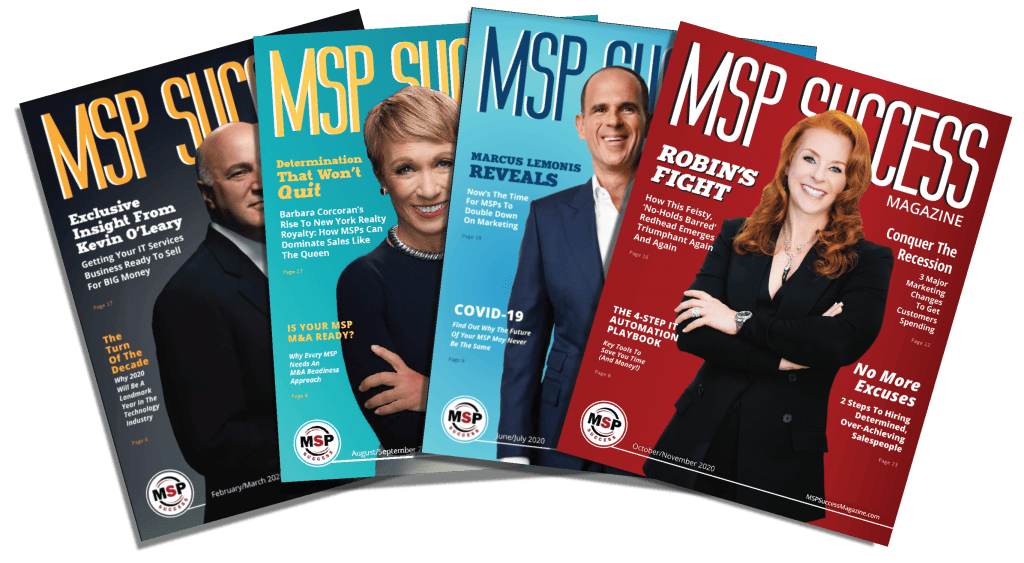You don’t start a race with the intention of dropping out. Similarly, nobody starts a business with the intention of failing. Yet about 1 in 5 companies in the United States don’t make it past the first year, and about 50% don’t make it past five years.
If you do make it past that five-year marker or beyond, you want to cross the finish line—whenever that is—strong, with a high valuation, not merely limping along, drained of energy and profits.
Whether you started your MSP business 10 days ago or 10 years ago, you can take steps now to get and keep your company healthy for the long run. These steps mirror some of the principles of longevity science that Dr. Peter Attia advocates for personal health: Plan for what you want your business to look like at the end of your tenure and take actions now to implement a business fitness plan to achieve that goal.
Start With The End In Mind
In the early days of a business, establish the value that you want to create, advises Paul Cissel, CEO of Growth Caddie, entrepreneur, and an M&A Expert in Residence at TMT. “How much money do I want this business to be worth? Start there” for your business fitness plan, says Cissel.

“Most business owners starting out don’t realize that exit strategy is business strategy,” agrees Scott Snider, president of Exit Planning Institute (EPI), growth specialist, and entrepreneur. “By focusing on things that make your business valuable, you create a better business today.”
Snider adds that you want your company to align with your business, personal, and financial goals and be “transferable at any time,” because while you may plan to run your business for 40 years, life sometimes forces your hand. Pointing to EPI data, he notes, “50% of the exits in our country today are involuntary due to these destroyers of business—a death, a divorce, a disability, a partner disagreement, a pandemic.”
That’s why it’s important to know your “number”—the amount of money you’re going to need to walk away, says Rayanne Buchianico, owner of ABC Solutions, which provides accounting, business, and tax consulting services to IT solution providers. And that number will change as you grow. So, “make sure that you can measure your profits at every step of the way,” counsels Buchianico.

“Just because you only have five clients, that doesn’t mean that you shouldn’t separate out your profit, your revenue streams, and manage the margins at each one of those revenue streams,” she says. “Make sure that you’re hitting the ones that you need in order to be successful.”
Build A “Fit” Foundation
Snider says four Cs will determine about 80% of your ultimate business value: human capital, customer capital, structural capital (your systems, processes, and financial structure), and social capital (your company culture).
He says structural capital is “the most robust” of these factors. This includes developing playbooks, standard operating procedures, and good financial documentation. Says Snider, “Those are the types of things that in those early years allow us to begin to set that foundation and begin to scale up so that the business owner … who’s likely the relationship builder and their sole salesperson, can go out and develop that customer capital and drive great relationships into the business for profitable revenue.”
Even for solo operators, Snider says, “it provides a level of discipline that allows you to scale. It’s kind of like working out every day. If you want to live a healthier lifestyle, it’s about eating right and training. Same thing in your business.”
While you’re developing your customer capital, be disciplined about establishing a target customer profile that allows you to achieve your value creation strategy, adds Cissel. Your customer profile guides the technology stack you support. Narrowing your stack to fit your customers enables better efficiency in service delivery, he says.
With your stack in place, focus on “the economics of margin” to get your pricing right, Cissel says. Don’t price based on the competition, but rather, “What is the value that I’m providing to my customers?”
Staying In Shape For The Lifetime Of Your Business
After you’ve established a healthy foundation, don’t slack on setting and reviewing annual goals, Buchianico says. “Your business plan should be updated every five years at a minimum,” she adds.

This is also a period of reinvestment, decentralizing yourself and building and empowering a leadership team, Snider says.
Buchianico agrees. “You’re the visionary. You don’t have to be the one plugging in the Ethernet cables anymore.” She advises training clients on how to open tickets and make requests early on. “Get them used to working with the others,” Buchianico encourages, “even if it’s just you.”
Once you’ve made the transition from technician to business operator, “understand that you need to make 20% profit,” says Cissel. “You need gross margins that are greater than 42%, you need service gross margins greater than 50%.”
Don’t Neglect Your Personal Growth And Goals
MSP business owners at this stage of scaling are familiar with the phrase, “Work on your business, not in it.” But what you don’t hear a lot as an entrepreneur, Snider says, is “stop living in your life and work on your life. I think every Boomer will be 60 years old this year or older. . . What you’re finding is that they’re still struggling a little bit with, ‘Who am I outside of my company, and how do I start to spend some time there?’”
If you’ve built a strong foundational business that can run independently from you, you can harness some of your personal goals and “live a little bit more of a fulfilling and well-rounded, holistic lifestyle,” Snider says.
Still, if you want your business in the best shape for an exit, “there’s very few small to medium-sized MSPs where you can be an absentee owner,” says Cissel. However, he adds, “You can get to where this is a fun business to run, and you don’t have to work those [long] hours” if you’ve put the right people, processes, and tools in place. The goal is to understand your value creation strategy and grow the best company you can, which is a company that somebody else wants.”
And like a good fitness program, “it’s never too late or too early to start planning,” says Snider, “whether you think you’re one year away from [exiting] or 40 years away.”












